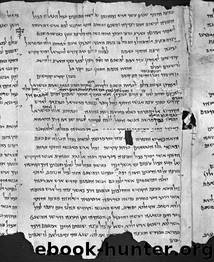Lost Books of the Bible for Dummies (ISBN by 0470243805)

Author:0470243805)
Language: eng
Format: mobi
Tags: &NEW
Published: 2011-07-01T01:27:52+00:00
21_243800-ch14.qxp 4/30/08 5:57 PM Page 259
Chapter 14: Traditions about St. Paul
259
Later Non-Biblical Letters and
Writings Attributed to Paul
Paul (shown in a mosaic in Figure 14-1) is most famous for his letters in the New Testament. They were addressed mostly to churches but sometimes to an individual (for example, Philemon is in fact a personal letter to an early Christian named Philemon). As we explain earlier, Pauline letters continued to be produced after Paul was long gone. Neat trick, eh?
In this section, we look at some of these later letters that were supposedly written by Paul, even though no one today really believes it. These letters include one that seems to be basically a patchwork from real letters, another tradition that consists of correspondence with the Roman philosopher Seneca, and finally another letter to Corinth!
Figure 14-1:
St. Paul.
Scala / Art Resource, NY
21_243800-ch14.qxp 4/30/08 5:57 PM Page 260
260 Part IV: Lost Early Christian Writings
The Epistle to the Laodicians
The Epistle to the Laodicians consists largely of sentences from genuine Pauline epistles strung together in a very short letter. It’s no surprise, then, that it sounds like Paul because most of it is! Consider the following familiar-sounding phrases:
And his mercy will work in you, that you may have the same love and be of one mind. Therefore, beloved, as you have heard in my presence, so hold fast and work in the fear of God, and eternal life will be yours. For it is God who works in you. And do without hesitation what you do. And for the rest, beloved, rejoice in Christ and beware of those who are out for sordid gain.
May all your requests be manifest before God and be steadfast in the mind of Christ. And do what is pure, true, proper, just and lovely. And what you have heard and received, hold in your heart, and peace will be with you.
—Epistle to the Laodicians 9–16 (tr. Elliott)
Still, this letter has been recognized as a later writing by early Church writers.
The Correspondence of Paul and Seneca
The Correspondence of Paul and Seneca is supposed to be an exchange of brief letters between Paul and the famous Roman philosopher Seneca (“The Younger”; 4 BCE–65 CE). However, we have no evidence from the known writings of Seneca that he ever carried on such a correspondence, and frankly, very little of any significance is said between them in this writing, other than mutual admiration.
That admiration, in itself, was probably the point; it’s possible that the writing was intended to show how even a famous Roman respects Paul. But beyond that, the Correspondence isn’t very thrilling. Seneca, for example, applauds Paul’s ideas but doesn’t say which thoughts he has in mind or why he likes them:
These thoughts, I believe, were expressed not by you, but through you; though sometimes they were expressed both by you and through you; for they are so lofty and so brilliant with noble sentiments that in my opinion generations of men could hardly be enough to become established and perfected in them. I wish you good health, brother.
Download
This site does not store any files on its server. We only index and link to content provided by other sites. Please contact the content providers to delete copyright contents if any and email us, we'll remove relevant links or contents immediately.
Plagued by Fire by Paul Hendrickson(17300)
The 5 Love Languages: The Secret to Love That Lasts by Gary Chapman(9530)
How to Bang a Billionaire by Alexis Hall(8042)
Wonder by R. J. Palacio(7884)
The Institute by Stephen King(6870)
The Space Between by Michelle L. Teichman(6821)
The Thirst by Nesbo Jo(6770)
The Testaments by Margaret Atwood(6682)
Assassin’s Fate by Robin Hobb(6066)
Wiseguy by Nicholas Pileggi(5618)
The Night Circus by Erin Morgenstern(5114)
Spare by Prince Harry The Duke of Sussex(5008)
Bittersweet (True North #1) by Sarina Bowen(4764)
The MacArthur Bible Commentary by John MacArthur(4690)
Everything Happens for a Reason by Kate Bowler(4619)
Tuesdays with Morrie by Mitch Albom(4612)
The Templars by Dan Jones(4602)
Gerald's Game by Stephen King(4522)
From Sand and Ash by Amy Harmon(4340)
